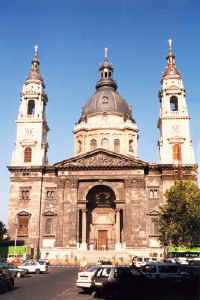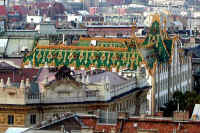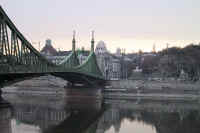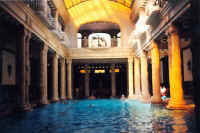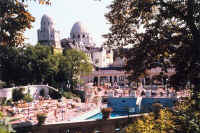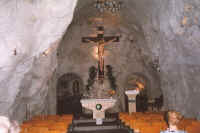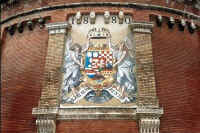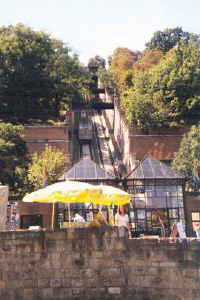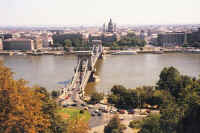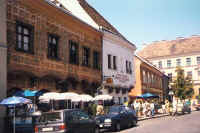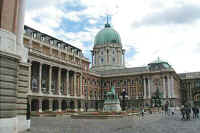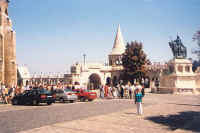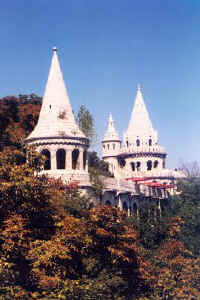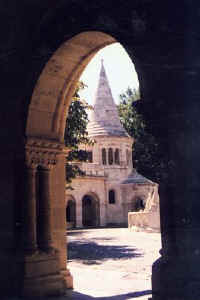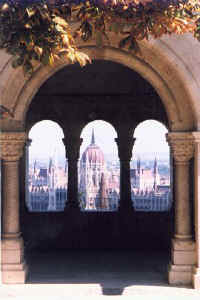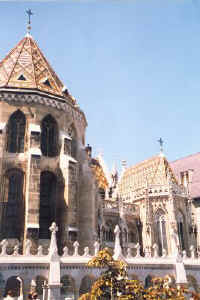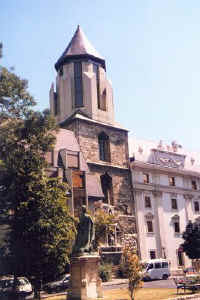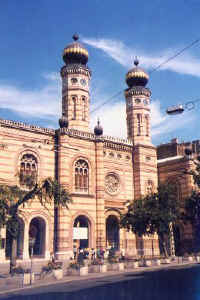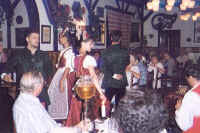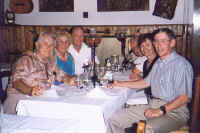|
Budapest
Friday, July 31: This was our first and only free day in Budapest, so we slept until 7:15. After breakfast we
walked back to St. Stephen's Basilica. Only 150 years old, it has spectacular mosaics lining the interior of the
dome above the main altar. In the Chapel of Leopold in the rear of the church is the supposed relic of St.
Stephen, who united Hungary and made it a Christian nation in 896, thus making it acceptable to other
European nations. The relic is his mummified right hand, the Holy Dexter, displayed in an ornate case shaped
like a small church. Viewers are required to pay 50 forints if they want the light turned on in the case.
Near the Basilica was a gingerbread-style building with a roof
of brightly-colored tiles. We had passed it several times before and
finally learned that it's the Post Office.
We caught a streetcar that took us across Victory Bridge (1896) to the Gellert Hotel (1918). The lobby of the hotel is not particularly impressive, but its spa and rehabilitation facilities are. Because of Jane's shoulder problem of recent months, she was particularly interested. The art nouveau style indoor pool, opened in 1934, is filled with warm mineral water from natural springs and is used for therapy. The larger outdoor pool also uses mineral water but is primarily for recreation. It even has mechanically generated waves.
The hotel and the hill behind it were named for St. Gellert, a Venetian priest (Gerardus) who served as tutor to King Stephen's son, Prince Imre. In 1046 during the chaos that followed Stephen's death, Gellert was killed by rebels trying to eradicate Christianity. According to legend, he was sealed in a barrel and rolled down the hill that now bears his name, into the Danube.
We also visited a chapel built in a cave across the street
from the hotel. Then we caught a streetcar
along the Danube to the funicular near the Chain Bridge. We rode the funicular up and had a great view back
across the Danube toward the Chain Bridge and our hotel.
We went back to Mathias Church and the Fishermen's Bastion,
exploring both at our leisure this time. Although there were still a lot of
people there, it was much less crowded than when we'd been there with the
tour group. For some reason, every single tour that goes the Mathias Church
goes there at the same time. We ran into Hans at the Fishermen's Bastion.
Jane was beginning to tire, so we walked backed to the Chain Bridge and across to our hotel, arriving after two.
While Jane went to the pool, I walked down the narrow streets of the Inner City to the Great Synagogue. The second largest synagogue in the world (after one in New York), it was built in the 1850s in a Moorish style. From there I walked to the Market Hall to buy a T-shirt for Gary Kardos, Jane's physical therapist, whose ancestors came from Hungary. Vaci street took me back to the hotel by 3:30.
The bus to the tour's farewell dinner left at 5:30 and took us to the Trombitas (Trumpets) Restaurant in Buda. They served dumpling or goulash soup, turkey (!) paprika, spaetzle, and a chocolate dessert. There was an aperitif and unlimited wine. Darrell was so thirsty from all his walking that he drank a whole liter of mineral water and very little wine. Five musicians, four dancers, and a singer, all in folk costumes, entertained us. We got back to the hotel around 8:30, but spent nearly an hour in the lobby saying our good-byes. We also were treated to a couple of songs by Mr. Kim, who had an excellent baritone voice. We stayed up packing until eleven. Then, after one last look at our spectacular view, we called it a night.
Copyright © 2000-2023 DarrellPeck.com All rights
reserved. | |||||||||||||||||||

